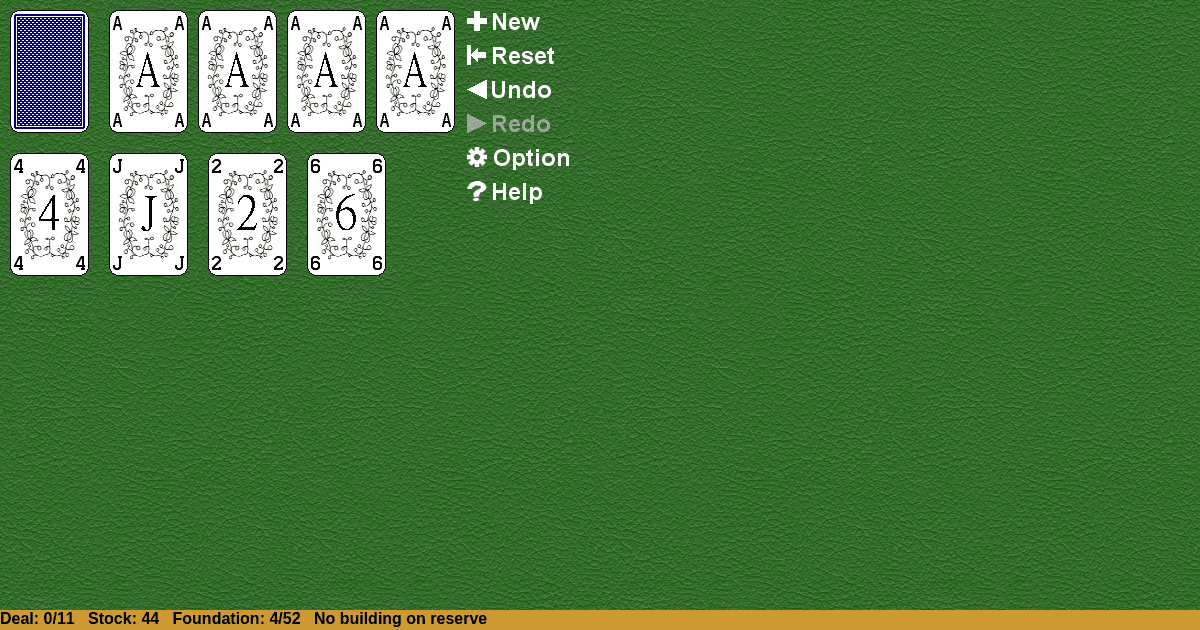Auld Lang Syne
Home |
How to play |
FAQ |
About
How to play Auld Lang Syne?
Game Objective:
The primary goal in Auld Lang Syne Solitaire is to move all cards from the tableau and stock onto the foundation piles, building each foundation in ascending order from Ace to King, regardless of suit.
Setup & Layout:
- Deck: Use a standard 52-card deck. Remove the four Aces and place them face-up in a row; these are the foundation piles.
- Tableau: Deal four cards face-up in a row directly below the foundations. Each card starts a tableau pile.
- Stock: The remaining 44 cards form the stock (draw pile), kept face-down.
- Play Areas Defined:
- Foundations: Four piles, each starting with an Ace.
- Tableau: Four piles, each with one face-up card.
- Stock: The undealt cards, face-down.
- Card Orientation: All cards in the tableau and foundations are face-up. The stock remains face-down until cards are dealt onto the tableau.
Auld Lang Syne Solitaire Rules:
- Building Foundations: Cards are built up in rank (Ace, 2, 3, …, King) onto the corresponding foundation piles. Suit is ignored; any card of the required rank may be placed, regardless of suit.
- Tableau Restrictions: Only the top card of each tableau pile is available for play. Cards cannot be moved between tableau piles, nor can sequences be built within the tableau.
- Card Movement: When a card from the tableau is moved to a foundation, the space remains empty until the next deal. No cards are moved directly from the stock to the foundations; all must first be dealt to the tableau.
- Dealing: When no further moves are possible, deal four cards from the stock—one onto each tableau pile, covering any existing cards (including empty spaces).
- No Redeal: Once the stock is exhausted, no further cards are dealt. There is no reshuffling or redealing of the stock.
Gameplay:
- Turn Sequence:
- Examine the tableau for cards that can be moved to the foundations (following ascending rank).
- Move all eligible cards from the tableau to the foundations.
- When no more moves are possible, deal four new cards from the stock—one onto each tableau pile (including empty piles).
- Repeat until the stock is depleted or all cards are built onto the foundations.
- Introducing New Cards: Only the stock supplies new cards, dealt four at a time onto the tableau.
- No Moves Available: If no tableau cards can be moved to the foundations and the stock is exhausted, the game ends.
Winning & Losing Conditions:
- Winning Condition: The game is won when all cards are built onto the foundation piles, each completed from Ace to King.
- Losing Condition: The game is lost if the stock is exhausted and not all cards have been moved to the foundations, with no further legal moves possible.
Special Rules & Edge Cases:
- Empty Tableau Spaces: When a tableau pile becomes empty (after its card is moved to a foundation), it remains empty until the next deal. During the next deal, a new card from the stock is placed on the empty space.
- No Tableau Building: Cards cannot be built or moved within the tableau; only the top card of each pile is playable to the foundations.
- No Redeal: There is no opportunity to reshuffle or redeal the stock once it is exhausted.
- Variants: Some informal variants allow building foundations by suit or permit a redeal after the stock is exhausted, but these are not part of the standard rules.
- Low Win Rate: The game is known for its very low probability of winning, estimated at less than 1% under standard rules.
Key Terms Defined:
- Foundation: A pile where cards are built up from Ace to King.
- Tableau: The main play area consisting of four piles, each with cards dealt from the stock.
- Stock: The face-down pile of undealt cards.
- Redeal: The act of reshuffling and dealing the stock again (not permitted in standard rules).

Solitaire Collection
About Auld Lang Syne
Rate (Auld Lang Syne)
4.7 / 5
1,916 votes



























































